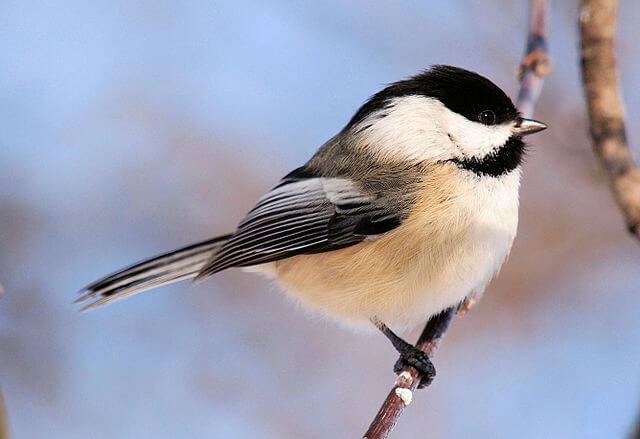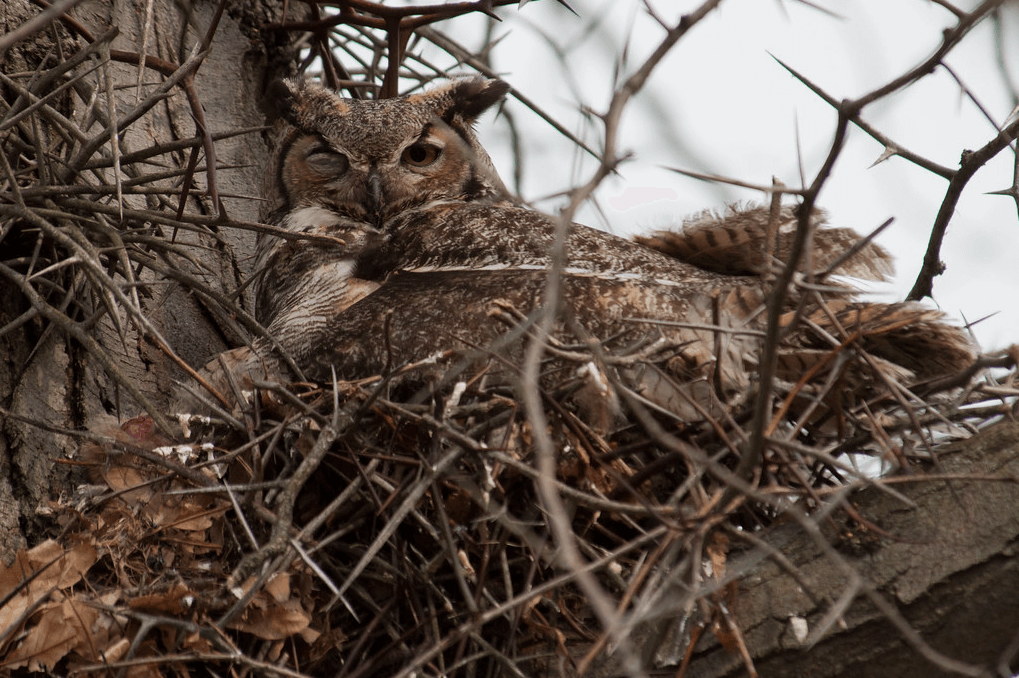The Amazing Brain Plasticity of the Black-Capped Chickadee
By Jen Elison
Broadcast 8.17 & 8.20.2021

Photo by Alain Wolf, CC 3.0.
Listen:
I think about brains whenever I am at the Farmer’s Market during the late summer. Like most Montanans, I anticipate the arrival of the Sanders County pickup truck loaded with mouthwatering Dixon melons. While I wait in line for my turn to pick out a sweet, juicy, flavorful treat my mind wanders to the wonders of the brain. You see, to me, the human brain looks similar in size and contour to the distinctive Dixon cantaloupe.
These cranial-shaped melons are harbingers of the upcoming shortening days and we cherish them because of their limited availability. And, despite the human brain’s capacity for executing such feats as the successful mission of the Mars Perseverance Rover, no one has yet come up with a method to store fresh cantaloupe over the winter. Late summer also heralds the season of caching for non-migratory birds, and they face a similar challenge; how to use their brains to solve winter food storage dilemmas.
In my estimation, the Black-capped Chickadee deserves the ornithology award as the ultimate prepper for the long, cold Montana winter. These songbirds must survive on stored seeds until the spring when they can again enjoy a more robust omnivorous diet. Weighing about the same as a AAA battery, Black-capped Chickadees spend the shortening days canvassing for seeds to store in hundreds of tiny hiding places embedded in their ten-mile territory. After watching chickadees purposely flit back and forth through the boreal forests of the Seeley Swan Valley, I became curious about how they remember where they have stored their winter provender.
What I have learned is that, despite the obvious difference in weight between human brains (tipping the scale at about three pounds) and chickadee brains (similar in weight to a raisin), there are commonalities in structure and function between the two species. Both human and Black-capped Chickadee brains contain hippocampal structures, the portion of the brain that plays a large role in spatial memory. And, within those seahorse-shaped brain features, are neurons that, like plastic, have the capacity for stretching and growing. In essence, the brain is capable of changing; brain circuitry can be re-wired. It is nothing short of a miracle.
According to psychology professor Diane Lee of Cal State University, the volume of the chickadee hippocampus expands by about 30 percent during the fall and retains its volume during the winter. The waxing and waning of the bird’s brain size coincides with the seasonal cycle. Come spring, the memory of where those seeds were hidden disappears and the size of the memory center returns to its pre-caching volume. In 2010, neuroscience researchers Sherry and Hoshooley reviewed current ornithology studies to better understand how the expanding and shrinking chickadee hippocampus contributes to survival. They concluded that the changes in hippocampal size might help the birds to store their caches further apart in an effort to deter other hungry animals from robbing their stores. Additionally, perhaps the growth in the hippocampus is needed only for encoding the cache, or it may be that the neurogenesis occurs for both encoding and retrieving the birds’ harvest.
Black-capped Chickadees have additional adaptive responses for dealing with the frigid nights of winter. Dr. Susan Chaplin from Cornell University, has been studying the winter habits of chickadees for 30-plus years. She found that they are able to lower their body temperature at night in order to conserve body fat. Night hypothermia, along with nocturnal shivering, growth of additional downy feathers near the skin, and tucking their heads into their back feathers at night to reduce heat loss, all add to the adaptive features needed to survive Montana winters. What triggers the brain to activate these adaptations, as well as the late summer hippocampal growth, remains a mystery.
We typically think of the chickadee as being adorable, partly because of its cheery personality, but also because of its oversized, dome-shaped head. Interestingly enough, the chickadee hippocampus is located at the top of its head, right underneath that perky black cap. I’m envious of both the seemingly perpetual optimism and amazing brain plasticity of the Black-capped Chickadee. They have every right to be proud of their “swollen heads” as they prepare for survival in the cold winter months.
Every week since 1991, Field Notes has inquired about Montana’s natural history. Field Notes are written by naturalists, students, and listeners about the puzzle-tree bark, eagle talons, woolly aphids, and giant puffballs of Western, Central and Southwestern Montana and aired weekly on Montana Public Radio.
Click here to read and listen to more Field Notes. Field Notes is available as a podcast! Subscribe on Apple Podcasts or wherever you listen to podcasts.
Interested in writing a Field Note? Contact Allison De Jong, Field Notes editor, at adejong [at] montananaturalist [dot] org or 406.327.0405.
Want to learn more about our programs as well as fun natural history facts and seasonal phenology? Sign up for our e-newsletter! You can also become a member and get discounts on our programs as well as free reciprocal admission to 300+ science centers in North America!












